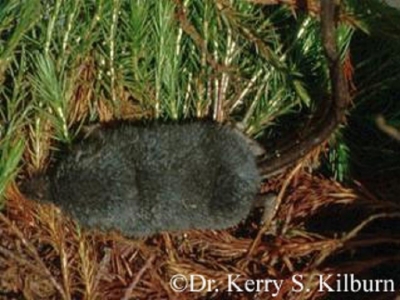Long-tailed Shrew Sorex dispar
The Long-tailed Shrew, also known as the Rock Shrew for its habitat preference, can be found in the mountains of middle and eastern Tennessee.
Description: A small, long-tailed mammal with a uniformly slate-gray, dense fur coat year round. It has a very long, pointed snout; a slender body; and tiny, black eyes. The long tail, which is slightly darker above than below, is thinly haired and is rather thick and rope-like.
Length: 4.0 - 5.3 inches
Tail: 1.9 - 2.6 inches
Weight: 0.25 ounces
Similar Species:
•Smoky Shrew is smaller with a shorter, thinner tail, and is paler below.
•American Water Shrew is larger with stiff hairs on its feet.
Habitat: Prefers cool and damp rocky slopes in coniferous and deciduous forests, sometimes areas with moss-covered rocks. Long-tailed shrews spend most of their time in the deep crevices between rocks about a foot beneath the surface.
Diet: Primarily eats small invertebrates such as centipedes, beetles, and spiders.
Breeding information: Very little is known due to their subterranean existence among rocks. Breeding occurs between April and August resulting in one or two litters. Females deliver 2-5 young per litter in underground nest sites among rock or boulder crevices.
Status in Tennessee: Long-tailed Shrews are uncommon throughout their range, and Deemed in Need of Management by both TWRA and Tennessee Department or Environment and Conservation.
Fun Facts:
•Long-tailed Shrews have relatively narrow skulls and incisors that stick out farther than normal (bucktoothed), which are adaptations designed to remove invertebrates from rocky crevices.
•The long tail likely aids it in balancing as it travels along rocks.
Best places to see in Tennessee: Talus slopes of cool, moist forests in Great Smoky Mountains National Park.
